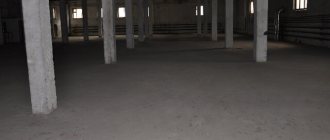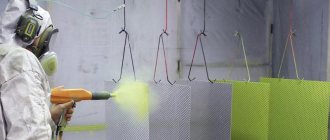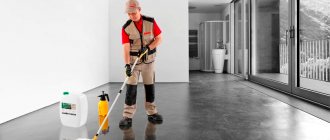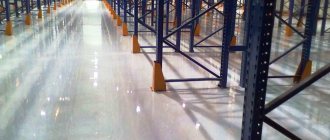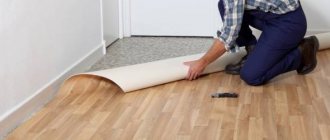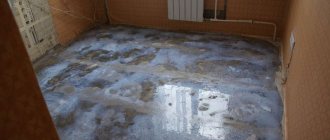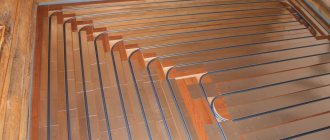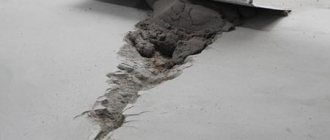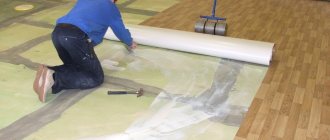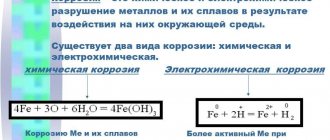Modern industry has led to the appearance on the market of many different finishing and facing materials, which in their technical characteristics are in many ways superior to past analogues. Polymer primer is one of these materials. It is deservedly popular because, along with similar polymer primers, it has many advantages and only one drawback.
Properties: why does a concrete base need protection?
The popularity of concrete floors in private construction is explained by the ease of making it yourself, using a minimal set of tools. The mixture includes a binder (cement), filler (gravel of various formations, sand, stone chips), improving additives and water, which makes the material affordable. The owners make a choice in favor of a concrete coating, taking into account other advantages of the material:
- Reliability, mechanical strength and long service life.
- Resistance to aggressive environments.
- Fire safety.
- Easy care.
However, the concrete surface begins to lose homogeneity over time, which is associated with two processes:
- Changes in temperature and humidity reduce the strength of the top layer, microcracks form on it, and then potholes appear.
- The porosity of the material, the release of salts to the surface, as well as its low tensile strength lead to the fact that under load the top layer begins to peel off. That's why the concrete floor gets dusty.
The garage floor is subjected to serious stress Source pinimg.com
The appearance of dust is a ubiquitous phenomenon, but most often it becomes obvious to the owner only after the floor has begun to be used. This situation is unacceptable not only for production, but also for a home garage or workshop.
To get rid of dust, special coatings for concrete floors are used. It is best to prevent the problem at the construction stage: after the concrete mixture has hardened, treat the surface with paint or another composition. As a result of the treatment, the pores on the surface will be clogged, and the wear resistance of the coating will improve.
In practice, several methods are used to protect concrete surfaces using different materials and technologies. Their diversity is enough to choose the most appropriate and effective option for specific conditions.
Primer for aerated concrete - what are its differences?
Aerated concrete or foam concrete is a building material that has a cellular structure. Despite the fact that it has high strength and a long service life, some problems may arise when working with it. It has an increased rate of moisture absorption, or rather, aerated concrete absorbs liquid.
For this reason, aerated concrete must be primed, this can protect it from moisture penetration. The polyurethane composition will quickly fill and clog large pores. As a result, a protective film with good water-repellent properties is formed on the surface of the material.
Topping systems
Topping is a dry mixture used to harden the surface of a concrete floor (another name is hardening mixture). The technology has the following features:
- The mixture is applied to fresh concrete (immediately after laying). It is distributed over the surface; for large areas, a distribution machine is used.
Grouting industrial concrete floors Source mpkm.org
- Topping consumption depends on the expected load. If the load is small or medium, use approximately 3 kg/m². For medium or heavy loads, the flow rate is increased to 4-5 kg/m².
- The mixture absorbs moisture from the concrete mixture and darkens, after which it is pressed in with a trowel. The topping becomes one with the concrete base.
The basis (binder) of the topping, like concrete, is cement. Fillers are responsible for the functional properties: quartz, corundum (mineral or synthetic), iron carbide, and other compounds. Chemical plasticizer additives control the filling and shrinkage process. Thanks to coloring pigments, the topping can obtain any shade and texture (smooth or grainy), so it is convenient to use as a topcoat.
The use of topping systems has a beneficial effect on surface characteristics as follows:
- Increases impact resistance and wear resistance. The service life of the surface increases several times, the risk of cracks and chips is significantly reduced.
Polished concrete screed in a garage Source nikastroy.ru
- Stops dust formation. The surface layer acquires a dense structure, becomes even and smooth. This facilitates dry and wet cleaning, which is useful from the point of view of hygiene and health.
- Light-colored toppings reflect light well, which allows you to save on lighting costs.
The use of toppings as a coating for concrete has the following limitations:
- It is more profitable to use dry mixtures in large areas (in workshops, warehouses, parking lots), where heavy equipment operates.
- They are not suitable for areas where chemicals are used (and spilled).
- In rooms with high humidity, sealing impregnations are additionally used.
Classification, features and scope of application of polyurethane primers
All primers are divided into two general types - one-component and two-component. In the first case, one type of solvent and one active element are used.
One-component solutions
will be an excellent option for application on surfaces made of wood, concrete, MDF boards.
Two-component primers
consist of a liquid mixture and a hardener, they are designed for deep impregnation. They are used for priming wooden and concrete bases. Mix the two components thoroughly before applying. The mixture increases the strength of surfaces several times.
Primers, impregnations, primers
Primer (primer) is a material that is used for preliminary preparation of the surface (if you are then going to apply the finishing coat). Primers are often (and erroneously) called impregnations, which, in fact, are independent impregnating sealing materials.
All these materials are not external, but penetrating; their main advantage is that they help to quickly and efficiently remove dust from the floor in the garage.
Concrete surface needs dust removal Source ad-cd.net
See also: Catalog of companies that specialize in finishing materials and related work
The basis of primers and impregnations are film-forming substances (polymers). The compositions may be natural or synthetic. After application, they penetrate into the pores of concrete and strengthen the loose structure, binding it with polymer molecules.
As a result, concrete practically stops dusting and becomes stronger. It better withstands negative temperatures and exposure to accidentally spilled acids and alkalis. To strengthen the concrete coating, the following types of impregnating materials are used:
- Polyurethane. Suitable for both primer and finishing layers, improve waterproofing and protect against abrasion. The floor is treated twice, undiluted. The best polymerization result is obtained at moderate temperatures (0-17°C) and humidity not lower than 70%. Polyurethane primer is often used to repair surfaces, for which it is mixed with sand.
- Water-dispersed. A budget option, made on a water basis, there is practically no smell. The main property is dust removal, the surface is slightly strengthened. Before application, water-dispersion mixtures are diluted with water.
Applying primer mixture Source opscool.ru
- Epoxy. The main property of epoxy primers is waterproofing. Like any epoxy resin-based materials, these are two-component formulations that must be mixed immediately before application and used at temperatures from +5°C.
Purpose and use of polymer primer
Polymer primer is designed to perform the following tasks:
- Formation of adhesion - the polymer primer penetrates deeply into the surface and binds it reliably. This task is the main one, so polymer primer is ideal for finishing surfaces that do not have pores or have a very smooth surface.
- Filling pores and eliminating minor flaws in the processed material.
- Reducing the consumption of polymer finishing, this applies to paints and plaster.
- The composition of the primer has strengthening properties, so another of its tasks is to strengthen the base being treated, eliminating dust and weak bases.
Paints for concrete
Paints of various compositions are widely used among concrete floor coatings. Since they are classified as finishing coatings, the surface is prepared before application: cleaned and primed. This increases the service life of the coating; it is only important to choose a primer based on the same polymer as the dye.
Epoxy paint
Epoxy paint forms the hardest and therefore wear-resistant coating for a concrete base, which can be used both indoors and outdoors. Epoxy resin paint can be used on freshly laid concrete; This feature reduces construction time.
A floor coated with epoxy paint has the following advantages:
- High waterproofing and no dust.
- Resistance to chemically active substances (solvents, oils, gasoline, acids and alkalis).
Epoxy paint for concrete Source beton-house.com
- Simplified care. The paint fills the pores in the loose outer layer of concrete, the dirt remains on the surface and is easy to remove.
- Increased wear resistance, aesthetic appearance. The paint does not wear off over time, does not turn yellow under the influence of ultraviolet radiation, and is convenient to use for marking.
Acrylic
Acrylic paints are mostly water-based, although there are more durable solvent-based options. The basis of the composite composition is polymer and acrylic resins, which form a durable, elastic and moisture-resistant polymer film.
To obtain the best result, the paint is applied to a dry floor, previously strengthened with acrylic primer (drying time up to 6 hours). It is applied in two steps, with a drying interval of 2 hours. Concrete coated with acrylic paint has the following advantages:
- Quick results. Less than a day passes from applying the primer to the start of operation.
- The base does not require leveling or perfect preparation.
- When dry, the acrylic layer acquires a dense matte texture, which visually evens out the base.
Acrylic paint for concrete floors Source beton-house.com
- The paint is affordable, and there are matte and glossy varieties on sale.
- Acrylic paint is easy to work with: applied with a brush, roller or spray, depending on the scale of the work.
Polyurethane
One way to protect the concrete surface and at the same time give it an attractive appearance is to use polyurethane dyes. Before applying polyurethane paint, the floor is prepared: dried, cleaned of dust, and oil (grease) stains are removed. Coloring is carried out in two stages, the second layer - no earlier than a day after the first.
The peculiarity of polyurethane-based paints is that they need from 2 to 14 days to dry completely. At the same time, the dye reaches a dry, tack-free state within a couple of days, after which small mechanical loads are acceptable.
During the remaining time, the polyurethane coating on the concrete floor continues to gain mechanical and chemical resistance. Using paint provides the following advantages:
- The dye is used for interior and exterior work and is highly resistant to weather vagaries.
Polyurethane two-component paint for industrial floors Source prom.st
Primer for concrete floors: application technology and coating preparation
If you decide to repair self-leveling concrete floors or plan to make a 3d epoxy floor, then you should first think about its protection. At the initial stage, it must be well primed, this will protect it from premature destruction, increase strength and wear.
Before applying polyurethane primer, it is important to prepare the floor:
- It is recommended to clean the surface from dust and dirt;
- Check the base to ensure there are no oil stains on it. If they are detected, then in this case the application of special solvents will be required;
- If cracks are detected, they must be repaired with putty;
- Looseness and unevenness need to be cleaned out.
Application of polyurethane primer is quite simple. The one-component material does not require preparation; it can be immediately applied to the base using a brush or roller. But a mixture of two components must first be prepared in accordance with the instructions. It is recommended to apply both types in several layers, each layer is applied after the previous one has dried.
Polyurethane primer for concrete is an excellent option for surface treatment. This material can perfectly prepare them for subsequent finishing. After them, you can safely apply floor enamel, glue wallpaper, sheathe with wood and other finishing materials. The main thing is to first consider their important features, types and rules of use.
Alternative coatings for concrete
You can protect concrete from destruction, and yourself from dust, without resorting to impregnations and paints. Alternative coatings for concrete can provide an aesthetic appearance to the floor and provide practical protection even in difficult garage conditions. The following materials can effectively protect a concrete base:
- Ceramic tile. Durable, easy to clean and abrasion resistant material. The best quality solution for a garage would be clinker tiles; The floor can also be covered with porcelain stoneware. A practical solution would be an unglazed or embossed material with a high level of abrasion (class five). Regular ceramic tiles will not withstand garage conditions.
Porcelain tiles for garage floor cladding Source design-homes.ru
- Rubber tile. Modular tiles made from rubber crumbs are suitable for garages, car washes or auto repair shops. It is resistant to salt solutions, motor oils and alkalis, and does not slip when wet. A fallen part or tool will not damage the coating and will remain intact. Important advantages of the modules are wear resistance, ease of cleaning and a wide color palette.
- PVC tiles. In the garage, a lot of time is spent on cleaning, especially with the arrival of winter with its slush and salt stains. PVC tiles will simplify the problem; This is an unpretentious coating, more durable than paint and less expensive than tile. Its assembly does not require cementation, and it does not slip during operation. If one element gets damaged, it is replaced without disturbing the structure.
Modular rubber tile floor Source pinimg.com
- Rolled rubber for the garage (also mats). A variety of products made from rubber and rubber crumbs; used in garages, fitness rooms, on treadmills. Main advantages: quick installation, no slipping, low abrasion, long service life (up to 20 years), varied appearance.
Self-leveling floors
This is the name of a special type of screed, for the production of which self-leveling mixtures are used. The main feature of the technology is the ability to create a coating of minimal thickness (up to 3.5 mm). Based on their use, self-leveling floors are divided into finishing and screeds; based on material, they are divided into mineral and polymer compositions, which differ in the pouring process.
A significant advantage of the technology (as opposed to cement screed) is its low labor intensity and high productivity. If the technology is followed, the mixture automatically levels itself to a horizontal plane. As a result, you get a durable and wear-resistant coating for concrete floors, the only disadvantage of which is its high cost.
Distribution of the mixture over the surface Source aviarydecor.com
Video description
About the benefits of impregnation for concrete in the following video:
The basis of mineral self-leveling floors is a cement mixture; additives are fillers that determine performance characteristics. There are three types of mineral mixtures on the market:
- Basic. It is used for initial alignment (adjustment is needed afterwards). Scope of application: concrete foundations with a slope of up to 80 mm.
- Average. Foundations whose slope does not exceed 30 mm.
- Finish. Performs final leveling for subsequent flooring installation.
Polymer self-leveling floors are needed where increased demands are placed on the surface in terms of reliability, abrasion resistance, and resistance to chemical influences. Polymer coatings for concrete are classified according to the thickness of the material or the composition of the mixture. Based on the binding component, the following types are distinguished:
- Epoxy polymer self-leveling floor. It is particularly durable and inert to chemically aggressive environments. Sold as a two-component mixture including working resin and thickener. The best option for indoor spaces with high loads (garage, warehouse, workshop, shopping center).
Self-leveling self-leveling floor Source twimg.com
- Polyurethane. Its peculiarity lies in its higher shock-absorbing properties. In practice, such a base will be more resistant to tension and impact loads. The application technology is more complex than for the epoxy analogue and requires more experience.
- Methyl methacrylate. Methyl methacrylate flooring hardens very quickly; use can begin within 2-3 hours, including outdoors, and even in frosty conditions. The disadvantage of the material is its price; It is also extremely difficult to apply without skill, especially over a large area. After hardening, the floor is harmless, but during the application stage it is necessary to ensure good ventilation and protect the respiratory tract (true for some brands).
Self-leveling floors in loft style (with topping) Source mpm-pol.ru
Choosing a quality primer
The selection of polyurethane mixtures for protecting concrete floors and walls must be carried out correctly.
It is important to follow some rules during this:
- High-quality primer solutions must contain an antiseptic. This component will protect against mold and mildew. It is especially important to use these mixtures for rooms with high humidity;
- For indoor surface treatments, it is worth using conventional primers, but façade impregnation is suitable for outdoor work;
- It is advisable to choose mixtures of well-known brands. At the same time, high-quality material may not always be expensive;
- Be sure to pay attention to the date of manufacture of the primer. Expired material loses its main qualities and is not suitable for surface treatment.
Offers from manufacturers
The construction market offers a huge variety of polyurethane primers. They are perfect for treating concrete surfaces before finishing. Many solutions can protect them from negative external influences, and they also increase the strength characteristics of any material.
The most popular brands of polyurethane mixtures in Moscow and other CIS cities include:
- Uzin PE 414 Turbo.
This brand of primers is made in Germany. There are two types of packaging on sale - 900 grams and 6 kg. Excellent for processing concrete, gypsum, cement. Hardening is quite fast - 1.5-2 hours. The material also has high moisture resistance and deep penetration.
- Wert Primer SF.
This is a domestic polyurethane primer that boasts excellent qualities. On sale it is found in buckets with a volume of 10 liters. It can be used to treat surfaces made of cement and concrete. But it has one unpleasant drawback - long-term hardening, which can take from 6 to 12 hours. The mixture makes the surface durable, improves its structure, protects from negative influences, and penetrates into deep layers.
- Ibola U.P.
A German-made primer is an excellent option for treating surfaces made of concrete, cement, gypsum, and wood. Available in different volumes - 1100 grams, 3 kg, 5 kg, 11 kg. Hardening is quite long - from 12 to 24 hours.
- Icar Primer PU.
The primer mixture is made in Italy. Available in canisters weighing 10 kg. Great for floors, walls made of concrete, cement. Hardening is long - from 6 to 8 hours. Reduces humidity, strengthens the surface, increases its strength, and penetrates into the deep structure.
Briefly about the main thing
Concrete pouring is an ideal option for organizing the floor in a garage, basement, workshop or other utility rooms. But such a coating requires additional protection, since during operation the concrete wears out and forms dust. To extend the service life of concrete, various methods are used to protect its surface.
The compositions used include topping systems, primers (primers), impregnations and paints. Depending on the composition, acrylic, epoxy and polyurethane materials are distinguished. A separate type of coating consists of self-leveling floors, as well as floor materials: ceramic, rubber and PVC tiles.
Ratings 0
